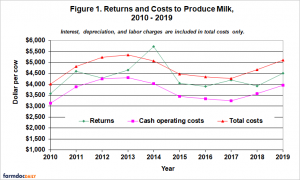Higher milk prices still resulted in continued negative economic returns for Illinois dairy producers in 2019, according to figures summarized by the Illinois Farm Business Farm Management Association.
The average net price received per 100 pounds of milk was $18.72, which was less than total economic costs of $21.34. The price received for milk in 2019 was $2.24 higher than 2018. On a per cow basis, total returns from milk were $4,500 compared to the total cost to produce milk of $5,103 per cow. Total returns from milk per cow increased from 2018. The net returns per cow in 2019 were a negative $602. Total returns have exceeded total economic costs only once out of the last ten years.
Milk production per cow for all herds averaged 24,018 pounds. The average was 293 pounds more per cow than in 2018.
Costs and Returns
Trends in total costs and returns per cow for all herds are given from 2010 to 2019 in Figure 1. The profit margin (return above all cost) increased — from a negative $747 in 2018 to negative $602 per cow in 2019. The last five-year returns above all costs has averaged a negative $451 per cow. During this period, returns above all costs per cow have varied from negative $60 in 2017 to negative $747 in 2018. In Figure 1, labor and interest charges are included in total costs only. Most dairy producers will incur hired labor and cash interest expense and would include them as cash operating costs.

The 2019 returns were 61 cents per 100 pounds produced more than the 2018 returns. The average net price received for milk was $18.72 per 100 pounds. This is $2.24 per 100 pounds or 14 percent higher than the average price received in 2018. Based on 24,018 pounds of milk produced per cow, this increase in price increased total returns per cow by $145 The average net price received for milk for the last five-year period is $17.49 per hundred pounds. Dairy assistance payments from the Farm Service Agency and patronage returns related to the dairy enterprise would add about 53 cents per 100 pounds of milk produced to returns in 2019.
While the price received increased, feed costs and non-feed costs per 100 pounds of milk produced increased. Feed costs in 2019 averaged $11.18 per 100 pounds of milk produced as compared to $9.95 in 2018. Feed costs were at their highest level ever in 2012. Feed costs have averaged $9.68 the last five years. The 2019 feed costs were $1.50 above the last five-year average. Feed costs were about 52 percent of the total cost to produce milk. Non-feed costs per 100 pounds of milk produced were $10.16 in 2019 compared to $9.76 in 2018. Total non-feed costs were the highest recorded in 2014.
Negative Profit Margins Continue for Dairy Producers in 2020 and 2021
2020 and 2021 milk prices are projected lower than 2019 and will not exceed economic costs resulting in continued negative profit margins for dairy producers. With lower milk prices, economic returns are projected to be below breakeven in 2020 and 2021. The average price received for milk in 2019 was 13.6 percent higher than the average in 2018. The average milk price for 2020 is projected to be about one percent less or about 12 cents per hundredweight lower than the average for 2019. Higher milk production, increasing cow numbers and uncertainties in the foodservice sector will lead to lower prices. United States milk production is expected to increase about two percent in 2020. 2021 projections from the United States Department of Agriculture show milk production increasing one percent from 2020 and milk prices decreasing 9 percent from 2020 estimates.
While milk prices decrease, feed costs for 2020 are expected to decrease. Corn prices will decrease in 2020 while soybean prices increase. Feed costs per 100 pounds of milk produced are projected to average about $11.09 using prices of $3.50 per bushel for corn, 18 cents a pound for protein and $150 per ton for hay. This is based on annual feed consumption per cow, including replacement animals, of 110 bushels of corn, 6,005 pounds of protein, and 9.3 tons of hay or hay equivalents. If non-feed costs per 100 pounds of milk produced averaged $10.20, total costs to produce 100 pounds of milk would be $21.29. A one percent decrease in milk prices in 2020 for Illinois producers would result in an annual price of about $18.60 per 100 pounds. If total economic costs averaged $21.29 per 100 pounds of milk produced, the average Illinois producer would have returns below total economic costs by $2.69 per 100 pounds of milk produced.
The data used in this study comes from farms across the State of Illinois enrolled in Illinois Farm Business Farm Management Association. Without their cooperation, information as comprehensive and accurate as this would not be available for educational purposes. FBFM, which consists of 5,500 plus farmers and 65 professional field staff, is a not-for-profit organization available to all farm operators in Illinois. FBFM field staff provide on-farm counsel with computerized recordkeeping, farm financial management, business entity planning and income tax management. For more information, visit the FBFM website at www.fbfm.org.


